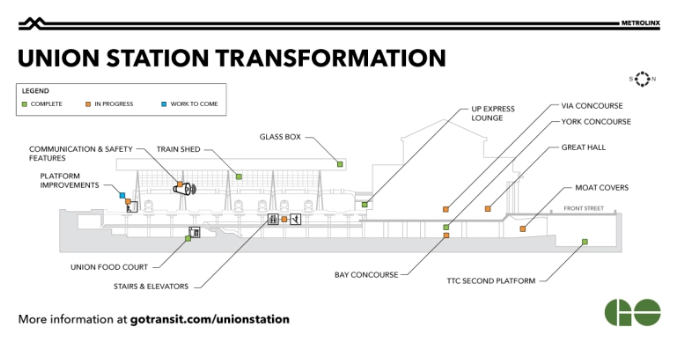Everything you need to know about the Union Station revitalization project

Union Station has been under ongoing construction as part of a City of Toronto multi-year revitalization project.
According to the city, the revitalization “will promote transit-oriented growth, improve the quality and capacity of pedestrian movement, restore heritage elements and transform Union Station into a major destination.”
The revitalization is an $800-million city initiative supported by investments of $164 million from the Government of Canada and $172 million from the Government of Ontario.
In essence, the project is tripling the size of Canada’s busiest transportation hub, which is why it feels like Union Station has been under construction for years.
Work so far
To date, the City of Toronto says that the excavation, or dig down, was one the most significant stages of the revitalization.
This initial part of the project involved digging several metres below Union Station’s existing floor level to create space for two new transit concourses and a new, lower-level retail concourse.
According to Metrolinx, last year also saw the installation of new electrical and mechanical systems, new stairs poured and elevator shafts constructed and reinforced. The City of Toronto is scheduled to complete its work later this year and then Metrolinx will customize the space.
And because Union Station is a National Historic Site, stonework in the Great Hall’s ceiling has been repaired and updated signage is being installed.
Most notably, the Union Food Court opened in November 2018. The Food Court was the first area to open in the newly-constructed lower retail level. It offers 10 food vendors and a seating capacity of more than 600 people in a 25,000-sq-ft space.
What’s next
The revitalization project continues this year.
Metrolinx says that there will be more space added this year outside of Union Station. That includes 25,000-sq-ft of outdoor walkways covered with steel and glass skylights around the perimeter of the station.
“These four canopies, known as moat covers on York, Bay and Front East and West, require more than 26,000 square feet of glass and 437 metric tonnes of steel. Their addition will protect passengers from inclement weather as they enter and exit the station, or when transferring to and from the TTC,” states a Metrolinx blog on the topic.
There will also be more work done on GO platforms to ensure that people are further away from passing trains.
Metrolinx is installing wider yellow tactile tiles along the platform edge, and they are installing infrastructure to support new digital signs, security cameras, lighting and an improved PA system.
Later this winter, there will also be renovation on the flooring, windows and doors in the Bay East Teamway.
The Bay Concourse will be increasing in size from 40,000-sq-ft to 61,000-sq-ft. When complete, and combined with the York Concourse, Union Station’s total GO concourse area will be more than triple its original size to 123,000-sq-ft.
Of that massive space, there will be an addition of 30,000-sq-ft of retail space. The Front Street Promenade, Union’s “Main Street,” will feature local and independent shops and restaurants.
According to the plan so far, the next retail spaces to open will be in the lower retail level, which will extend underneath the Bay Concourse and the Bay Promenade.
As the space is growing, there will be more stairs and elevators between concourses and platforms.
Next year will also see restoration work to the seating areas in the VIA Concourse, which has already been improved with new tiling and higher ceilings.
While it has been taking a while, the changes to Union Station are needed more than ever.
Last fall, the province announced the largest GO service increase in five years.
Travellers on the Lakeshore corridors now access to 220 new trips per week, an increase of nearly 18% that before.
Weekday GO Train service between Niagara Falls and Toronto also began this January.
So for commuters taking trains out of the city with VIA Rail, or just taking the GO to and from work, there are at least better food options, and will be more places to wait for transit indoors when it’s really cold outside.
And don’t forget your PRESTO.





